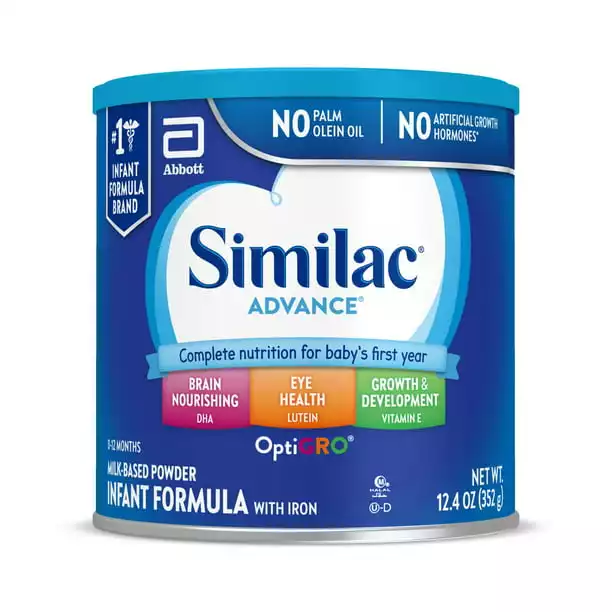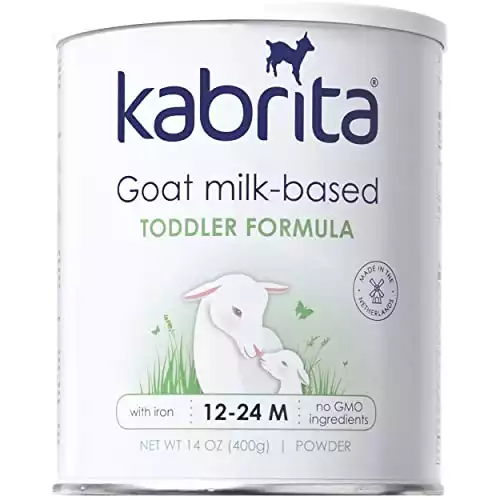- How to choose baby formula - September 4, 2023
- Best amino acid-based formulas 2024 - September 4, 2023
- Best hypoallergenic formulas 2024 - August 30, 2023
Getting the right baby formula is an important choice that all parents will have to make. The problem is, there are so many brands out there – where do you begin? To help narrow down your search and to make life that little bit easier, this review will cover Similac Advance vs Sensitive.
Both are manufactured by popular baby brand Similac, but as you’ll see throughout this guide, they’re both two very different formulas.
In this guide, we’ll talk you through the pros, cons, and key features of each baby formula. By the end, we hope you’ll have a clear understanding of what either can offer your infant when it comes to nutrition, ingredients, and overall likeness to breast milk.
This is a milk-based formula for your baby's first year that is specially designed for fussiness and gas due to lactose sensitivity
Jump to a specific section
- Main differences between Similac Advance vs Sensitive
- Things to Think About Before Buying Your Baby Formula
- Similac Advance vs Sensitive – An in-depth Comparison
- Similac Advance Overview
- Similac Sensitive Overview
- Are there any alternatives to Similac Advance and Similac Sensitive?
- The Verdict: Similac Advance vs Sensitive
- FAQs
- Final Thoughts
Main differences between Similac Advance vs Sensitive
The main differences between Similac Advance vs Sensitive are:
- Similac Advance is a milk-based formula, whereas Similac Sensitive contains milk protein isolate instead of milk.
- Similac Advance is for babies without sensitivity to lactose, whereas Similac Sensitive is specially created for babies who are lactose intolerant.
- Similac Advance contains 11g lactose/100kcal, whereas Simila Sensitive 0.1g lactose/100kcal.
Things to Think About Before Buying Your Baby Formula
Nutritional content
The first six months of your baby’s life are some of the most crucial. It’s important therefore that the right nutrition is administered during this time. When it comes to protein, you don’t want to give your infant too much as it could lead to obesity later on in life. Aim for around 10g of protein per day when your child is 0-6 months old.
Carbohydrates are essential for your child’s growth and development. 95g per day is about enough for your infant and should provide them with plenty of energy while helping to maintain healthy body weight.
Types of formula
As you’re probably aware, the formula comes in two forms: ready-to-drink and powder. Ready-to-use formula is best suited to newborns if you’re choosing not to breastfeed. They’re easily digestible and can be given to your baby anywhere and everywhere.
The powdered formula is best for babies over 6 months. If your baby is allergic to cows’ milk then soya alternatives are available. Powdered formula is the most economical and lasts much longer than ready-to-drink options. It does take a little more time and effort to mix up though.
Ingredients
There are two main ingredients found in some baby formulas that are considered to be controversial. These are DHA (Omega-3) and ARA (Omega-6). While both ingredients are good fatty acids that help the brain and nerves develop, they are not naturally found in a baby formula like they are in breast milk. Instead, they are usually processed with hexane, which can be toxic in high doses.
Be aware of this ingredient when you look for your formula. While they are usually found in baby formula in only very small doses, it’s important that you are aware so that you can have a think about whether you are comfortable feeding it to your baby.
Your baby’s age
It’s really important to choose a baby formula that fits your child’s age range. This should be clearly displayed on the label, but each one will be specially formulated to include the right nutrients for each stage of your baby’s life.
Iron-fortified
If your baby isn’t being breastfed at all, then look for a formula that contains iron. You’ll want to feed them this ingredient from birth until they are 12 months old. This is important because boosting iron levels in the blood can prevent anemia.
Similac Advance vs Sensitive – An in-depth Comparison
At this point in our guide, we’ll be going into more detail about each formula. This includes the pros, cons, and key features that you’ll find important, allowing you to make a decision about which one is best for your baby.
Similac Advance Overview
Similac Advance is packed with key nutrients to help your infant thrive. This includes Lutein, which helps eyes grow strong and healthy, and Vitamin E – an essential part of your baby’s health. It also contains 2’-FL Human Milk Oligosaccharide.
You might not have heard of this (this ingredient isn’t too well known), but it’s an immune-boosting prebiotic that naturally occurs in breast milk. Similac claims that it’s backed by more than 15 years of extensive research and adds another layer to Similac’s already proven immune support.
Similac Advance – or any other formula in their repertoire – doesn’t contain artificial growth hormones. This means that the dairy ingredients come from cows that haven’t been treated with hormones for advanced growth. Many parents prefer this.
Another great thing that we should mention about Similac Advance is that it’s available to purchase from a variety of drug stores and grocery chains. This means that if you run out in the middle of the night, you should be able to find some in the early hours of the morning.
As with any baby formula, your baby might not take to Similac Advance straight away. It’s also quite expensive compared to other brands, which is important to consider if you’re looking for something long term. It’s also not necessarily the best option for newborns as it doesn’t quite have all the key ingredients they’ll need. This formula is better suited for babies aged 6-12 months.
Features:
- A nutritionally complete formula, which provides nutrients and vitamins for babies up to 12 months old.
- As close as possible to breast milk in terms of nutrients.
- It contains 2’-FL Human Milk Oligosaccharide. This is an immune-boosting prebiotic found in breast milk.
- Available in a 1.45 lb or 12.4 oz powder formula, or 1 qt ready-to-feed bottle.
- The #1 brand chosen by moms (Total US infant formula, all outlets as of 3/31/2018, Nielsen data).
Similac Advance Infant Formula is a nutritionally complete, milk-based formula for your baby's first year with all ingredients carefully selected to meet our high standards
Pros:
- Provides enough nutrients needed to replace breast milk for your baby’s first year of life.
- The powder formula dissolves completely and quickly when mixed with the right amount of water.
- It tastes a lot like breast milk.
- It contains Similac Opti-Grow. This is Similac’s own mixture of DHA, Lutein, and Vitamin E. All of these provide enough nourishment for your baby’s health and development.
Cons:
- Not all babies’ stomachs take to the formula straight away.
- It’s quite expensive compared to other brands.
- Similac Advance doesn’t provide all the vitamins your baby needs from age 6 to 12. Similac Advance 2 is a better option for very young children.
Similac Sensitive Overview
Similac Sensitive is designed for sensitive tummies, fussiness, or gas issues caused by an intolerance to lactose. The formula contains milk protein isolate instead of milk, meaning that the lactose has been removed. This makes it suitable for babies with an allergy to dairy, including cows’ milk.
Like Similac Advance, the Similac Sensitive is made with vitamin E and lutein. This is to ensure babies grow up to be healthy and strong. It also contains 2’-FL Human Milk Oligosaccharide. Overall, Similac Sensitive is designed to mimic the taste and texture of breast milk to ensure your infant ingests all they need for a healthy start to life without compromising on the quality of their food.
Similac Sensitive also contains iron. This is a key ingredient for newborn children in the first year to stop them from developing anemia. And for your own ease, you can get the formula in either a powder or ready-to-drink format. The latter is especially handy if you’re on the go or need something easy to grab during busy times of the day.
There have been some instances where Similac Sensitive has been known to cause constipation. This is quite rare but will depend on your baby’s tolerance. Keep an eye on how they react and if the problem persists, seek professional help.
Features:
- Features no artificial growth hormone.
- A milk protein isolate formula designed for your baby’s first year.
- Specially designed for fussiness and gas due to lactose sensitivity.
- Contains immune-boosting 2’-FL Human Milk Oligosaccharide.
- Features OptiGRO; an exclusive blend of DHA, Lutein, and Vitamin E.
- Available in a 1.4 lb or 12 oz powder formula, or 1 qt ready-to-feed bottle.
- The #1 brand chosen by moms (Total US infant formula, all outlets as of 3/31/2018, Nielsen data).
This is a milk-based formula for your baby's first year that is specially designed for fussiness and gas due to lactose sensitivity
Pros:
- The nutritional value overall is very good.
- It’s more affordable than other brands.
- It’s an effective formula in helping to alleviate fussiness in babies.
- It’s easy to prepare and use.
- There are lots of forms and sizes available to choose from.
Cons:
- While cheaper than Similar Pro Sensitive, it’s still considered quite expensive.
- It doesn’t contain prebiotics.
- It’s been known to cause constipation.
- The taste is strong – your baby might not like it and reject the formula.
Are there any alternatives to Similac Advance and Similac Sensitive?
For sensitive tummies:
Kabrita Goat Milk Formula
Goats’ milk is a great alternative for any baby who can’t consume cows’ milk. Kabrita is a goat-milk-based formula that contains additional whey proteins, DHA, ARA, and vitamins that all help with intolerance, while providing key nutrients your baby needs to grow and thrive. It’s very similar to human breast milk, making it also easier to digest and full of nutrients.
Proudly crafted in The Netherlands with no GMO ingredients, Kabrita Goat Milk Toddler Formula is naturally easier to digest than cow milk, mild in taste, and rich in critical nutrients.
For babies with normal digestion:
Gerber Gentle
Made from cows’ milk, Gerber Gentle comes with a blend of prebiotics, ARA, and DHA. This mix resembles the compounds found in breast milk. It’s actually been designed to taste just like regular milk because it has proteins that are less broken down. This is great if your baby is more sensitive to proteins.
This gentle formula features a blend of DHA, prebiotics, and comfort proteins, small proteins that are easy for tiny tummies to digest It's our closest formula to breastmilk.
The Verdict: Similac Advance vs Sensitive
While there are some clear similarities between Similac Advance and Sensitive, you’ll have noticed that there are many key features that set them apart from one another too. Ultimately, you will have the final choice on which one you consider to be best for your baby. However, based on our reviews above, we’ve picked a winner – Similac Sensitive.
One of the main reasons why this formula comes out on top is because it’s a fantastic option for babies with sensitive stomachs. As it’s made with protein isolate instead of milk, infants will still get all the goodness from dairy without the gassiness and constipation that comes with it. Choosing a formula that’s kind and gentle will give your child a great start to life.
Similac Sensitive also has the added benefit of iron. This prevents anemia from developing and is crucial for your baby’s first year of life. Iron is an ingredient that is often overlooked, so it’s great that Similac has included it as a key part of their nutritional profile.
Finally, while still on the expensive side, it’s more affordable than Similac Advance. Cost is a key factor when choosing any brand of formula because it means you can stick to it. The formula that is more expensive can eat into your finances, meaning you might have to switch to save money. This isn’t ideal when you’ve found a formula that works for your baby.
However, Similac Advance still has a ton of nutritional benefits. If you’re reading this guide and feel that you’d like to try it with your baby, we’d be happy to recommend it.
FAQs
Is Similac Advance good for newborns?
Similac Advance is a nutritionally complete formula. It provides key nutrients and vitamins suitable for babies up to 12 months old. Its taste and texture is very similar to breast milk, and it’s made with 2′-FLHuman Milk Oligosaccharide. This immune-boosting prebiotic was previously only found in breast milk, making it a safe choice for babies.
However, it’s important to remember that like with any formula, gas and vomiting are still possible. Your baby may also struggle with the taste.
How do you use Similac Advance?
• Wash your hands, surfaces, and utensils.
• Pour water into a clean bottle.
• Add 1 unpacked level scoop (8.3 g) to each 2 fl oz of water.
• Return dry scoop to the container.
• Cap bottle; shake well; attach nipple.
• Once feeding begins, use within 1 hour or discard.
How long can I keep Similac ready to feed?
After preparing your bottles in advance, they should be refrigerated until you are ready to use them. The refrigerated formula only keeps for around 48 hours, so if you haven’t managed to use your formula within this time, discard it immediately.
Is Similac Sensitive lactose-free?
This formula is milk-based and designed for babies with lactose intolerance. The typical value of lactose in Similac Sensitive is 0.1g/100kcal. Comparatively, Similac Advance contains 11g lactose/100kcal.
Does Similac Sensitive cause gas?
Because Similac Sensitive contains milk protein isolate instead of milk, the lactose has been removed. This makes this particular formula gentler for babies who may be sensitive or intolerant to lactose. As a result, your infant shouldn’t suffer from discomfort because of gassiness. Keep an eye on how it works for your baby.
How long is Similac Sensitive ready to feed good for?
Because it doesn’t need to be prepared with water, the ready to feed version of Similac Sensitive is an easy and convenient option, especially when you’re on the go. Once opened, the entire contents should be used within three days. Discard after this amount of time if it remains unused.
Final Thoughts
Now that you’ve come to the end of our guide, you should hopefully have all the information you need to make a decision between Similac Advance and Sensitive. Both have a long list of pros, but you’ll ultimately find that only one is the right formula for you.
This is a milk-based formula for your baby's first year that is specially designed for fussiness and gas due to lactose sensitivity
If you liked this article, why not check out some of our other reviews? Discover which is best between Enfamil vs Similac, or our review of the Baby K’tan Original Baby Carrier.






Leave a comment